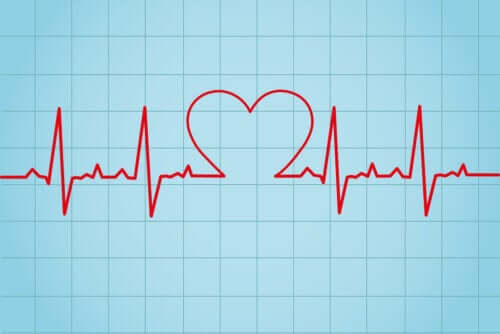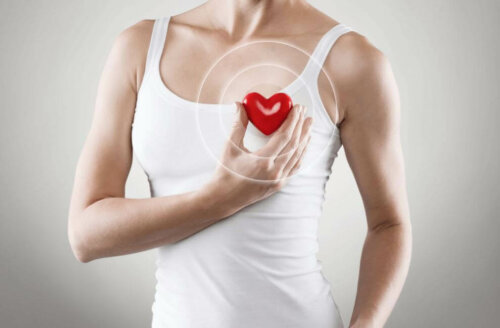The Increase in Heart Rate During Physical Activity


Written and verified by the nurse Maria Marin Garcia
Heart rate (HR) is the number of heartbeats per minute (bpm) and an increase during physical activity is normal. The normal average value at rest is 60-100 bpm, although it fluctuates depending on the needs of every organism.
There are different conditioning factors during rest such as genetics, sex, age, psychological state, physical shape, posture, altitude, temperature, smoking, among others. This data is useful to find out quickly and easily how the heart works. It also allows us to get to know the intensity of the physical activity we perform.
Daily physical activity reduces the resting heart rate and improves the quality of life by getting us in better shape. It helps the heart exert less effort every day, as it’s “better trained.” So, how does physical activity impact the heart rate? Let’s analyze it.

Why does heart rate increase during physical activity?
The main organs to have an impact during physical activity are the heart and lungs. The latter ones are responsible for the exchange of oxygen (O2) and carbon dioxide (CO2). It gets O2 to increase muscle function and eliminates CO2 as organic waste from the organism.
The heart is in charge of pumping oxygen-charged blood to the muscles in order to provide them with the necessary energy. It then allows the CO2-laden blood to go to the lungs and come out.
The muscles need to work harder when we exercise. Thus, the body needs to consume O2 and expel CO2 in greater quantities. This is because there’s an increase in energy demands.
Check out these Six Cardio Exercises You Can Do at Home
Consequences of exercise

Due to the above, an increase in cardiac pumping is necessary to allow the muscles to perform their activity normally. Furthermore, just as there’s an increase in heart rate, there’s also an increase in the number of breaths. It helps the heart during physical activity.
A resting heart rate is usually 60-100 bpm. However, the normal number of heartbeats can vary between 120 and 160 bpm during exercise.
The maximum rate the heart can reach peak exercise depends on age and one can estimate it with this formula: 220-age=maximum heart rate.
Normal symptoms of increased heart rate and breathing during exercise
According to the process explained above, one can summarize that physical activity produces different symptoms in our bodies.
- A person begins a physical activity without noticing the increase in their heart rate or breathing pattern
- After a few minutes, the muscles may tingle and the legs may feel heavy
- Breathing increases progressively and then there’s shortness of breath, fatigue, coughing, or wheezing
- The heart pulse is faster and stronger than usual; we usually know this as “elevated heart rate”
- There’s a slight pain, tightness in the chest, and palpitations
- The feeling of discomfort at the beginning of physical activity may stabilize or even disappear and allows a person to continue it normally
Read about Seven Subtle Ways to Increase Physical Activity Every Day
When should you be concerned?
An extreme increase in heart rate during exercise may be a sign of heart problems. In addition, late recovery of normal heart rate afterward could also be a sign of such conditions.
The continued increase in heart rate coupled with shortness of breath could be a sign of a respiratory condition. For this reason, it might be a good idea to use heart rate monitors to control the heartbeats per minute. Also, to monitor breathing during and after physical exercise.
Be clear on this
An increase in heart rate during physical activity is normal. However, it’s important to watch out for the warning signs that may indicate cardiac or respiratory problems. Consult a doctor if this is the case.
All cited sources were thoroughly reviewed by our team to ensure their quality, reliability, currency, and validity. The bibliography of this article was considered reliable and of academic or scientific accuracy.
- Frecuencia cardiaca y entrenamiento – Fundación Española del Corazón 2020. Available from: https://fundaciondelcorazon.com/ejercicio/calculo-y-monitorizacion/3161-frecuencia-cardiaca-y-entrenamient.html
- Variabilidad de la frecuencia cardiaca en un deportista juvenil durante una competición de bádminton de máximo nivel | Revista Andaluza de Medicina del Deporte. [cited 2020 Apr 22]. Available from: https://www.elsevier.es/es-revista-revista-andaluza-medicina-del-deporte-284-articulo-variabilidad-frecuencia-cardiaca-un-deportista-13139224
- Buscador SEC – Sociedad Española de Cardiología. 2020. Available from: https://secardiologia.es/buscador?searchword=ejercicio fisico&searchphrase=all
- European Lung Foundation. Los pulmones y el ejercicio.2020 . Disponible en: https://www.europeanlung.org/assets/files/es/publications/lungs-and-exercise-es.pdf
This text is provided for informational purposes only and does not replace consultation with a professional. If in doubt, consult your specialist.








